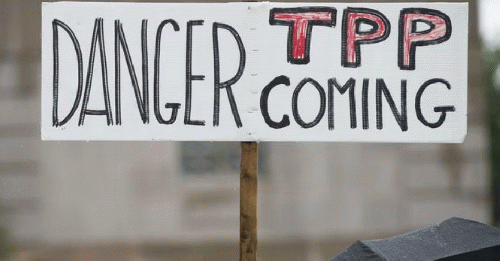
TPP Danger Sign
(Image by sputniknews.com/business/20151018/1028717548/tpp-threat-canada.html) Details DMCA
The Peterson Institute for International Economics (PIIE) released a report today that trumpets embarrassingly small gains from the Trans-Pacific Partnership trade agreement. The PIIE and media headline writers wrongly focus upon one number - $141B increase to US incomes - to create the illusion of future prosperity from the TPP.
The truth is different for three reasons. First, the economic model used is faulty, has consistently produced incorrect results and should not be used for this purpose. Second, even though the PIIE model is used to produce the most optimistic of all possible predictions, there is no future job creation and negligible growth. Third, other econometric models ignored by the PIIE, but used by other economists, find job loss and economic shrinkage from the TPP.
1. Faulty Economic Model Used: The PIIE used the controversial computable general equilibrium (CGE) model to analyze the TPP rather than models that produce less optimistic results. The CGE model is increasingly recognized as unreliable because:
1.1. Untrue Facts Assumed: The CGE model requires one to assume that untrue facts are actually true" to wit, that full employment always exists, that trade is in balance, that wages and productivity stay in alignment rather than diverge, and that all countries have perfectly free markets with rational economic behavior. All of these assumptions are false because: full employment rarely exists; trade is almost never in balance; wages have diverged downward from productivity for the past several decades; and many TPP countries have state-directed capitalism or strong industrial policies to influence and alter market outcomes.
1.2. Untrue Past Results: The US International Trade Commission (USITC) used the CGE model to project the future economic results of granting Permanent Normalized Trade Relations with China (China PNTR) (passed in 2000) and also for the Korea-US trade agreement (KORUS) (implemented in 2012). Both times, the CGE model mislead Congress and the public as to the results to be expected.
1.2.1.China PNTR: The USITC estimated, using the CGE model, that China PNTR would improve the US trade balance with China. US exports to China would increase by 10.1% and US imports from China would increase less, by 6%. (USITC 1999, TableES-4, xix). In 1999, the US had a $68.7 billion annual trade deficit with China. Now, the US now has a $337 billion annual trade deficit with China. (US Census Bureau)
1.2.2.KORUS: The USITC estimated, using the CGE model, that the annual U.S. trade deficit with Korea would improve by about $4-5 billion. Instead, this deficit worsened by $12 billion annually between 2012 (date of KORUS implementation) to 2015.
1.3. Untrue Assumption of No Net Job Losses: The CGE model wrongly assumes that there are no job losses to produce its results. The International Trade Administration assumes that for every billion dollars of U.S. exports supported 5,796 jobs, down from 7,117 jobs per billion dollars of U.S. exports in 2009. Conversely, every billion dollars of imports has the opposite result. Thus, where trade agreements result in worsening trade deficits, as is the case for the NAFTA, Korea and China PNTR deals, the job losses are drastic. The income gains projected by the CGE model do not and cannot occur.
1.4. Currency Misalignment, Border Taxes, Industrial Policy Ignored: The PIIE model incorrectly assumes that currency valuations will be set by the perfectly free market and will not be manipulated. It does not take into account rising foreign value added taxes - which replace tariffs - charged to imports from the US. It also ignores the industrial policy and state-directed strategies that Japan, Vietnam and others use to give an advantage to state-influenced or national champion domestic industries. The fact that foreign auto import penetration into the Japanese market has remained static at 6% after decades of tariff reduction is not recognized in the PIIE model.
2. The PIIE Admits the TPP will Create No Jobs and Little Growth: Assuming, for the sake of discussion, that the CGE model's conclusions are true:
2.1. Job Creation Will Not Occur: The PIIE Study admits that "the TPP is not likely to affect overall employment in the United States". (Report, pg 3).
2.2. Income gains are Negligible: The study projects that, by 2020, US incomes will rise a mere 0.1% of GDP. (Table 2). This means that 99.9% of growth will happen without regard to the TPP. The number 0.1% is equivalent to, or less than, a rounding error. It can only come true if all untrue assumptions in the CGE model are true. It will take another 10 years for the optimistic projection to deliver a meager 0.5% income gain by 2030.
2.2.1. The Middle Class Will Not Benefit: Assuming (which we do not) the small income gains are realized, the study is silent on who benefits from them. The Economic Policy Institute reported that trade agreements account for 90% of wage inequality. If there are any income gains, the middle class will be a net loser.
2.3. Other countries will "benefit" more than the US: The Peterson Study projects that Japan, Malaysia and Vietnam will gain far more than the United States. The US Trade Representative, by pushing the TPP, is helping open markets for competitors in Japan and other countries. Japan is estimated to gain five times more income (in relation to GDP) than the US, Vietnam 16 times more, and Malaysia 15 times more. (Report, Table 2).
(Note: You can view every article as one long page if you sign up as an Advocate Member, or higher).




